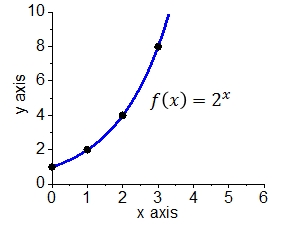Operations for functions: Exponential and logarithmic functions
 Exponential functions
Exponential functions
Exponential functions occur naturally in real life. Consider, for example, the number of bacteria that grow in a culture medium where each minute every bacterium splits into two bacteria. If we start with one bacterium, then after one minute we have two bacteria, after 2 minutes 4 bacteria, and so on:
| Time (in minutes) | Number of bacteria |
| 0 | 1 |
| 1 | 2 |
| 2 | 4 |
| 3 | 8 |
| 4 | 16 |
| 5 | 32 |
If \(x\) is the number of minutes that have passed and \(y\) is the number of bacteria, the equation that describes the growth is \[y=2^x\tiny.\] Clearly, #y# is a function of #x#. The graph of this function is shown below.

The function \(2^x\) is an of an example of an exponential function:
Exponential function
If \(a\) is a positive real number, then the function \[f(x)= a^x\] is called the exponential function with base \(a\). Its domain is #\mathbb{R}#.
The reason for requiring the base \(a\) to be positive is related to the fact that for negative values of \(a\) the power \(a^x\) is not always defined. For example, if #a=-2# and #x=\frac{1}{2}#, then #a^x=(-2)^{\frac{1}{2}}# is a number squaring to #-2#, but no such number is real.
Later we will see that, if #a\gt1#, the exponential function #a^x# grows faster than any power function.
The function \(f(x)=x^a\), “raising \(x\) to the power \(a\)”, where the independent variable is the base \(x\), is a power function, but not an exponential function.

Or visit omptest.org if jou are taking an OMPT exam.



